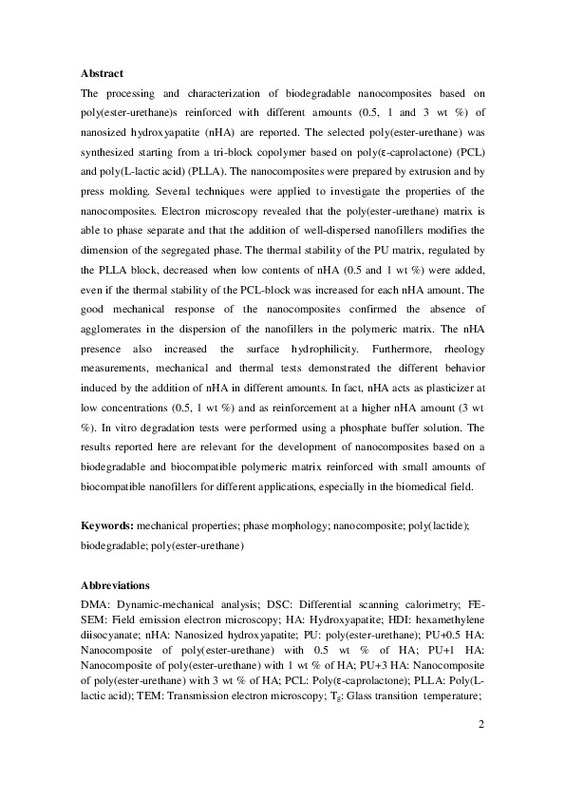Navarro-Baena, I.; Arrieta, MP.; Sonseca Olalla, A.; Torre, L.; López, D.; Giménez Torres, E.; Kenny, JM.... (2015). Biodegradable nanocomposites based on poly(ester-urethane) and nanosized hydroxyapatite: Plastificant and reinforcement effects. Polymer Degradation and Stability. 121:171-179. https://doi.org/10.1016/j.polymdegradstab.2015.09.002
Por favor, use este identificador para citar o enlazar este ítem: http://hdl.handle.net/10251/79147
|
Título:
|
Biodegradable nanocomposites based on poly(ester-urethane) and nanosized hydroxyapatite: Plastificant and reinforcement effects
|
|
Autor:
|
NAVARRO-BAENA, IVÁN
Arrieta, Marina Patricia
Sonseca Olalla, Agueda
Torre, Luigi
López, Daniel

 Giménez Torres, Enrique
Kenny, Jose Mª
PEPONI, LAURA
Giménez Torres, Enrique
Kenny, Jose Mª
PEPONI, LAURA
|
|
Entidad UPV:
|
Universitat Politècnica de València. Instituto de Tecnología de Materiales - Institut de Tecnologia de Materials
Universitat Politècnica de València. Escuela Técnica Superior de Ingenieros Industriales - Escola Tècnica Superior d'Enginyers Industrials
Universitat Politècnica de València. Departamento de Ingeniería Mecánica y de Materiales - Departament d'Enginyeria Mecànica i de Materials
|
|
Fecha difusión:
|
|
|
Resumen:
|
The processing and characterization of biodegradable nanocomposites based on poly(ester-urethane) reinforced with different amounts (0.5, 1 and 3 wt %) of nanosized hydroxyapatite (nHA) are reported. The selected ...[+]
The processing and characterization of biodegradable nanocomposites based on poly(ester-urethane) reinforced with different amounts (0.5, 1 and 3 wt %) of nanosized hydroxyapatite (nHA) are reported. The selected poly(ester-urethane) was synthesized starting from a tri-block copolymer based on poly(epsilon-caprolactone) (PCL) and poly(L-lactic acid) (PLLA). The nanocomposites were prepared by extrusion and by press molding. Several techniques were applied to investigate the properties of the nanocomposites. Electron microscopy revealed that the poly(ester-urethane) matrix is able to phase separate and that the addition of well-dispersed nanofillers modifies the dimension of the segregated phase. The thermal stability of the PU matrix, regulated by the PLLA block, decreased when low contents of nHA (0.5 and 1 wt %) were added, even if the thermal stability of the PCL-block was increased for each nHA amount. The good mechanical response of the nanocomposites confirmed the absence of agglomerates in the dispersion of the nanofillers in the polymeric matrix. The nHA presence also increased the surface hydrophilicity. Furthermore, rheology measurements, mechanical and thermal tests demonstrated the different behavior induced by the addition of nHA in different amounts. In fact, nHA acts as plasticizer at low concentrations (0.5, 1 wt %) and as reinforcement at a higher nHA amount (3 wt %). In vitro degradation tests were performed using a phosphate buffer solution. The results reported here are relevant for the development of nanocomposites based on a biodegradable and biocompatible polymeric matrix reinforced with small amounts of biocompatible nanofillers for different applications, especially in the biomedical field. (C) 2015 Elsevier Ltd. All rights reserved.
[-]
|
|
Palabras clave:
|
Mechanical properties
,
Phase morphology
,
Nanocomposite
,
Poly(lactide)
,
Biodegradable
,
Poly(ester-urethane)
|
|
Derechos de uso:
|
Reserva de todos los derechos
|
|
Fuente:
|
Polymer Degradation and Stability. (issn:
0141-3910
) (eissn:
1873-2321
)
|
|
DOI:
|
10.1016/j.polymdegradstab.2015.09.002
|
|
Editorial:
|
Elsevier
|
|
Versión del editor:
|
http://dx.doi. org/10.1016/j.polymdegradstab.2015.09.002
|
|
Código del Proyecto:
|
info:eu-repo/grantAgreement/MINECO//MAT2013-48059-C2-1-R/ES/SINTESIS Y CARACTERIZACION DE POLIURETANOS AUTORREPARABLES FOTORREACTIVOS MULTIFUNCIONALES Y DE SUS NANOCOMPOSITES PARA EL SECTOR DEL TRANSPORTE/ /
info:eu-repo/grantAgreement/CAM//S2013%2FMIT-2862/
info:eu-repo/grantAgreement/MINECO//MAT2014-55778-REDT/ES/BIOPOLIMEROS Y MATERIALES COMPUESTOS SOSTENIBLES/
|
|
Agradecimientos:
|
We are indebted to the Spanish Ministry of Science and Innovation (MICINN) for their economic support of this research (MAT2013-48059-C2-1-R and MAT2014-55778-REDT) as well as the Regional Government of Madrid (S2013/MIT-2862). ...[+]
We are indebted to the Spanish Ministry of Science and Innovation (MICINN) for their economic support of this research (MAT2013-48059-C2-1-R and MAT2014-55778-REDT) as well as the Regional Government of Madrid (S2013/MIT-2862). LP acknowledges also, the support of a JAEDoc grant from CSIC cofinanced by FSE. We thank the technical support of Prof. Juan Lopez Martinez from Universitat Politecnica de Valencia (Spain) for his assistance with water contact angle measurements, as well as Marco Rallini and Franco Dominici from the STM group of the University of Perugia for FE-SEM photographs and microextruder blending, respectively.
[-]
|
|
Tipo:
|
Artículo
|






![[Cerrado]](/themes/UPV/images/candado.png)



